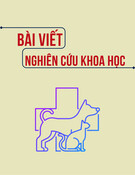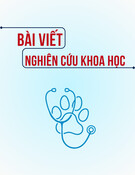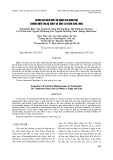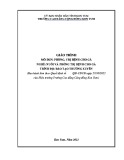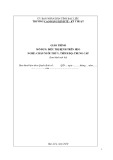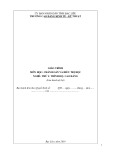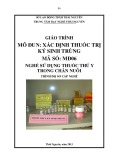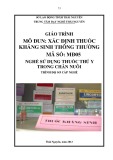
Vietnam Journal
of Agricultural
Sciences
ISSN 2588-1299
VJAS 2021; 4(1): 978-988
https://doi.org/10.31817/vjas.2021.4.1.08
https://vjas.vnua.edu.vn/
978
Received: May 19, 2019
Accepted: January 25, 2021
Correspondence to
nguyenhoainam@vnua.edu.vn
An Overview of Drug Effects on Bone
Healing on Animal Research Models
Nguyen Hoai Nam1 & Naruepon Kampa2
1Faculty of Veterinary Medicine, Vietnam National University of Agriculture, Hanoi
131000, Vietnam
2Faculty of Veterinary Medicine, Khon Kaen University, Khon Kaen 40002, Thailand
Abstract
Bone fracture is a common health problem in humans and animals,
and the healing of the bone fracture is a complicated process. Several
drugs may be used concurrently with the treatment of fractures, but
they may interfere with the healing process of the bone. The present
research reviewed previously published studies with the objective to
enhance the understandings of the effects of different drugs on bone
healing. There is clear evidence that antibiotics, corticosteroids, non-
steroidal inflammatory drugs, and chemotherapeutic drugs all affect
bone healing. By contrast, the effect of anticoagulants on bone
healing is controversial, so more research is needed to determine its
efficacy. In addition, there is no direct evidence to approve the effect
of anesthetics on bone healing, so this is another area in need of
further research.
Keywords
Animal model, bone healing, drug, rat femur
Introduction
Bone fracture causes harmful effects to patients’ health, degrades
their quality of life, and is responsible for costly treatments.
Annually, millions of musculoskeletal procedures are performed
worldwide (Jahangir et al., 2008). Each year, billions of dollars have
been spent for the treatments of bone fracture and hip replacement,
and the number has been increasing over time. In 2005, more than
USD 20 billion was spent on medical care for over 300,000 spinal
fusions (Porter et al., 2009). Pathogenic bone defects caused by
cancer were responsible for more than 3,000 pediatric
hospitalizations, and cost over USD 70 million (Porter et al., 2009).
In animals, about 800,000 pets are involved in vehicle crashes
annually in USA (Strickland, 2014). High rise syndrome may cause
limb fracture in 46.2% of fallen cats, of which 38.5% of fractures are
in forelimbs and 61.5% were in the hind limbs are. Tibiae are most
commonly fractured followed by the femur (Vnuk et al., 2004). The
treatment cost of bone fractures in companion animals can procure

Nguyen Hoai Nam & Naruepon Kampa (2021)
https://vjas.vnua.edu.vn/
979
several million Vietnam Dong per case.
Antibiotics, anti-inflammatory drugs and
anesthetics are usually used during treatment of
bone fracture. Sometimes, anticoagulants or
chemotherapy drugs may be applied in
orthopaedic animals treatments. All of these
drugs may have some effects on the course of
bone healing. The pharmacological factors
associated with bone healing in humans and
animals are similar in many aspects; therefore,
understanding these factors is useful and can
enhance the successful treatment. This narrative
review focuses on the effects of drugs used on the
bone healing process based on the information
retrieved from an extensive literature review.
Effects of Drugs on Bone Healing
Prevention and/or treatment of diseases may
involve many types of drugs. They can be
generally divided into 6 groups including
antibiotics, corticosteroids, non-steroidal anti-
inflammatory drugs (NSAIDs), anticoagulants,
chemotherapeutic agents and anesthetics. When
used in animals with bone fractures, some of
these drugs may interfere with the bone healing
process. Tables 1-5 present the effects of such
drugs on fracture healing in animal models.
Effects of Antibiotics on Bone Healing
Many antibiotics have been reported to
affect bone healing including quinolones (Gough
et al., 1996), ciprofloxacin (Huddleston et al.,
2000), levofloxacin and trovafloxacin (Perry et
al., 2003), tetracycline (Kim et al., 2004) and
cefuroxime (Natividad-Pedreño et al., 2016).
Effect of gentamicin on bone healing is
controversial. Kim et al. (2004) reported that it
decreased bone formation, however, Fassbender
et al. (2013) and Haleem et al. (2004) did not find
similar results. Cefazolin had no effect on
fracture healing parameters including callus
mechanical resistance and histological scores
(Natividad-Pedreno et al., 2016). Also,
vancomycin did not influence biomechanical and
radiographic scores of healing bone (Haleem et
al., 2004). Interestingly, doxycycline inhibited
osteolysis, and is suggested for prevention and
treatment of wear particle-induced osteolysis and
aseptic loosening (Zhang et al., 2007).
The negative effects of antibiotics on bone
healing may be due to their high doses such as
100 mg/kg/day for cefuroxime (Natividad-
Pedreno et al., 2016) and ciprofloxacin
(Huddleston et al., 2000), 70 mg/kg/day for
trovafloxacin and 50 mg/kg/day for levofloxacin
(Perry et al., 2003), and due to long treatment
durations, such as 3-4 weeks (Huddleston et al.,
2000; Perry et al., 2003; Natividad-Pedreño et
al., 2016). Antibiotics play a pivotal role in
prevention and treatment of bacterial infection in
many diseases and procedures, especially,
orthopedic cases. The use of antibiotics is
inevitable as long as their doses and durations are
carefully calculated and followed.
Effects of corticosteroids on Bone
Healing
In vivo studies have demonstrated that many
corticosteroids including cortisone (Sissons &
Hadfield, 1955), prednisolone (Luppen et al.,
2002; Yaghini et al., 2017), prednisone (Bostrom
et al., 2000; Waters et al., 2000),
methylprednisolone (Xie et al., 2011) and
dexamethasone (Sawin et al., 2001) affected the
bone healing process. The common aspect of
these studies wa that the duration of treatments
was prolonged, i.e., 42 days for dexamethasone
(Sawin et al., 2001), 56-78 days for prednisolone
(Luppen et al., 2002; Yaghini et al., 2017) and 96
days for prednisone (Bostrom et al., 2000;
Waters et al., 2000). On the other hand, when
used for a shorter duration, i.e., 14-21 days,
corticosteroid doses were very high, i.e.,
20mg/kg/day for methylprednisolone (Xie et al.,
2011), and 10-20 mg/kg/day for cortisone
(Sissons & Hadfield, 1955). With a similar
duration of treatment (21 days) but several times
lower doses (0.5 mg/kg/day), no significant
effect of prednisolone on fracture healing was
observed although the numeric values of the
mechanical parameters were lower in the treated
group (Bissinger et al., 2016). Being used for 4
consecutive days, methylprednisolone at 2
mg/kg/day (Hogevold et al., 1992) and
prednisone at 0.02 mg/kg/day (Aslan et al., 2005)
had no effect on bone healing.

An overview of drug effects on bone healing on animal research models
980
Vietnam Journal of Agricultural Sciences
Table 1. In vivo effects of different antibiotics on bone healing
Drug and dosage
Animal and
bone
Results
References
Cefazolin: 50 mg/kg per day, daily for
4 weeks. Cefuroxime: 100 mg/kg per
day, daily for 4 weeks.
Rat femur
Cefuroxime decreased callus mechanical
resistance and lowered histological grade.
Cefazolin did not influence studied parameters.
Natividad-
Pedreno et al.
(2016)
Gentamicin: 10% gentamicin coated
implant.
Rat tibia
Local application of gentamicin did not influence
tibial fracture healing.
Fassbender et al.
(2013)
Doxycycline: 2 and 10 mg/kg per day
for 7 days.
Mouse calvaria
Doxycycline inhibited osteolysis. Suggestion for
use of doxycycline for treatment or prevention
of wear particle-induced osteolysis and aseptic
loosening.
Zhang et al.
(2007)
Tetracycline: 30 mg/graft.
Gentamicin: 15 mg/graft.
Rat calvaria
Antibiotics impaired bone formation.
Kim et al. (2004)
Gentamicin: 1.5 mg/kg, twice per day
for 3 weeks. Vancomycin: 25 mg/kg,
twice per day for 3 weeks.
Rat calvaria
Antibiotics had no effects on biomechanical and
radiographic scores.
Haleem et al.
(2004)
Levofloxacin: 25 mg/kg,
trovafloxacin: 35 mg/kg. Both drugs
were used twice a day for 3 weeks,
started 1 week post femoral fracture.
Rat femur
Antibiotic induced less woven bone and more
cartilage in the fracture sites.
Perry et al. (2003)
Ciprofloxacin: 50 mg/kg, twice a day
for 3 weeks, 1 week post femoral
fracture.
Rat femur
Decreased radiographic results, lowered
torsional strength, and abnormal cartilage
morphology were observed in the treatment
group.
Huddleston et al.
(2000)
Quinolones: 100, 350, 500, 750
mg/kg per day for 5 days.
Rabbit joints:
shoulder, hip,
knee
Drug caused degenerated or hypertrophic
chondrocytes, loss of collagen and
proteoglycan. Effects were not clearly dose-
related.
Gough et al.
(1996)
The negative effect of corticosteroids on
bone healing was consistent in the literature,
especially if the high doses and/or long
treatments were applied. Nonetheless, there is
also some evidence that corticosteroids can be
used for a short time with appropriate doses if
their benefits outweigh their potential side
effects.
Effects of non-steroidal anti-
inflammatory drugs on Bone Healing
The inhibitory effect on bone fracture
healing is attributable to many NSAIDs,
including indomethacin (Brown et al., 2004;
Hogevold et al., 1992; Lack et al., 2013),
ketorolac (Gerstenfeld et al., 2003), etodolac
(Endo et al., 2002), diclofenac (Bissinger et al.,
2016; Krischak et al., 2007), ibuprofen (Kidd et
al., 2013; Leonelli et al., 2006), dexketoprofen
and meloxicam (Inal et al., 2014), aspirin (Lack
et al., 2013), parecoxib (Gerstenfeld et al., 2003),
rofecoxib (Leonelli et al., 2006) and celecoxib
(Simon & O'Connor, 2007). Most of these
NSAIDs doses were below or comparable to the
recommended dosage for treatment of diseases in
humans. Only some of these studies used high
doses of NSAIDs, i.e., indomethacin at 12.5
mg/kg/day, aspirin at 100-300 mg/kg/day (Lack
et al., 2013), and rofecoxib at 8 mg/kg/day
(Leonelli et al., 2006). Impaired fracture healing
may be partially due to long-term exposure to
drugs, including diclofenac for 21 days
(Bissinger et al., 2016), rofecoxib and ibuprofen

Nguyen Hoai Nam & Naruepon Kampa (2021)
https://vjas.vnua.edu.vn/
981
Table 2. In vivo effects of corticosteroids on bone healing
Drug and dosage
Animal and bone
Results
References
Prednisolone: 4 mg/day for 4
weeks, followed by 2 mg/day for
another 4 weeks.
Dog mandible
Prednisolone decreased bone-implant contact.
Yaghini et al.
(2017)
Prednisolone: 0.5 mg/kg per day,
daily for 21 days.
Rat femur
No significant effect of prednisolone on bone
healing was evident although the absolute values
of mechanical parameters in prednisolone group
were lower in comparison with the control.
Bissinger et al.
(2016)
Methylprednisolone: 20 mg/kg per
day, three times on day 16, 15 and
14 pre-surgery.
Rabbit femur
Methylprednisolone induced osteonecrosis,
impaired healing and maturation of bone tissue.
Xie et al. (2011)
Prednisone: 0.02 mg/kg, 4
consecutive days started prior to
surgery.
Rat femur
Prednisone had no effect on bone healing.
Aslan et al.
(2005)
Prednisolone: 0.35 mg/kg per day,
three times a week for 6 weeks
before surgery.
Rabbit ulna
Prednisolone inhibited bone healing characterized
by a small callus area, low torsional strength.
Luppen et al.
(2002)
Dexamethasone: 0.05 mg/kg per
time, twice every day for 42 days
since surgery.
Rabbit spine
Dexamethasone decreased the rate of bone graft
union.
Sawin et al.
(2001)
Prednisone: 0.15 mg/kg per day,
60 days before osteotomy until 6
weeks postosteotomy.
Rabbit ulna
Prednisone induced bone loss.
Bostrom et al.
(2000)
Prednisone: 0.15 mg/kg per day,
60 days before osteotomy to 6
weeks post-surgery.
Rabbit ulna
Prednisone caused lower results in callus size,
radiographic density, bone mineral content and
mechanical strength.
Waters et al.
(2000)
Methylprednisolone: 2 mg/kg, 4
consecutive days started prior to
surgery.
Rat femur
Methylprednisolone had no inhibitory effect on
bone healing.
Hogevold et al.
(1992)
Cortisone: 10, 20 mg/kg per day for
14 days.
Rabbit femur and
tibia
Longitudinal bone growth instantly stopped after
the commencement of cortisone administration.
The cartilage was thinned as soon as day 6. By
day 24 extensive destruction of metaphyseal
trabeculae was apparent.
Sissons &
Hadfield (1955)
Cortisone: 20 mg/kg per day for 21
days.
Rat femur and
tibia
The harmful effect of cortisone on bone growth in
rats was less severe than in rabbits.
for 28 days (Leonelli et al., 2006), ketorolac and
parecoxib for 35 days (Gerstenfeld et al., 2003),
indomethacin, celecoxib for 28, 56 or 112 days
(Brown et al., 2004). The inhibitory effect of
NSAIDs on fracture healing was observed even
when the treatment durations and doses were
comparable to ordinary prescription, ie.,
indomethacin at a dose of 2 mg/kg/day for 4 days
(Hogevold et al., 1992), etodolac at 20
mg/kg/day for 7 days (Endo et al., 2002) and
celecoxib at 4 mg/kg/day for 5 days (Simon &
O'Connor, 2007).

An overview of drug effects on bone healing on animal research models
982
Vietnam Journal of Agricultural Sciences
Although there are a few studies supporting
the use of some NSAIDs, such as ketorolac
(Cappello et al., 2013; Fracon et al., 2010),
paracetamol, etoricoxib (Fracon et al., 2010)
during bone healing treatment, there are far more
studies reporting the newgative impact of bone
healing. Therefore, use of NSAIDs during
fracture healing should only be considered when
the drugs’ benefits over-ride their negative
impacts (Table 3).
Effects of anticoagulants
on Bone
Healing
The use of anticoagulants for prevention of
thrombosis and pulmonary embolism in
traumatic and orthopedic cases is common
(Prodinger et al., 2016). Anticoagulants may
elicit inhibitory effects on osteoblast formation,
and may intensify bone resorption (Kapetanakis
et al., 2015). Enoxaparin has been found to exert
a negative effect on fracture healing in rabbit ribs
(Street et al., 2000, whereas this drug does not
influence bone healing of rat femur (Curcelli et
al., 2005; Demirtas et al., 2013; Say et al., 2013).
Bone fracture healing is independent of many
anticoagulants, including heparin (Curcelli et al.,
2005; Erli et al., 2006), dalteparin (Erli et al.,
2006; Hak et al., 2006; Say et al., 2013),
certoparin (Erli et al., 2006), nadroparin (Say et
al., 2013), and rivaroxaban (Demirtas et al.,
2013). Rivaroxaban increased the callus volume
but decreased bone mineral density resulting in
unchanged mechanical parameters (Kluter et al.,
2015; Prodinger et al., 2016). It appears that
negative effects of anticoagulants on bone
fracture healing is still minimal. A definitive
conclusion of the effect of anticoagulants on
bone healing is impossible discern due to the
differences in drugs used, time of drug exposure,
drug doses, animal models, fractured bones, time
of evaluation and means of evaluation. Therefore,
these drugs are still a gold standard for prevention
of thrombosis and pulmonary embolism in
animals with bone fracture(s). Nevertheless, more
well-designed studies are required to determine
the true effects of anticoagulants on bone fracture
healing (Table 4).
Effects of chemotherapeutic agents
on
Bone Healing
Chemotherapeutic agents are commonly
prescribed for treatment of cancers and chronic
inflammation. High doses are recommended for
oncological treatment, and low doses are for
chronic inflammation (Cavalcanti et al., 2014).
Results show that these drugs are also
significantly involved in the bone healing
process. Fracture healing was completely
prevented by angiogenesis inhibitor TNP-470 via
suppression of both intramembranous and
endochondral ossifications (Hausman et al.,
2001). Histological and radiographical
Table 3. In vivo effects of NSAIDs on bone healing
Drug and dosage
Animal and
bone
Results
References
Diclofenac: 5 mg/kg per day for 21 days.
Rat femur
Diclofenac decreased stiffness, trabecular
thickness and callus volume.
Bissinger et
al. (2016)
Dexketoprofen: 0.98 mg/kg per half a day,
meloxicam: 0.2 mg/kg per day, diclofenac:
1mg/kg per day. All drugs were used for 10
days.
Rat fibula
Dexketoprofen and meloxicam inhibited bone
fracture healing while diclofenac did not.
Inal et al.
(2014)
Indomethacin: 12.5 mg/kg per day. Aspirin:
2.7 mg/kg per day, 10 mg/kg per day, 50
mg/kg twice per day, 100 mg/kg three times
per day. All drugs were used for 8 weeks.
Rabbit ulna
Aspirin at 10 mg/kg and 100 mg/kg, and
indomethacin decreased bone healing.
Lack et al.
(2013)

